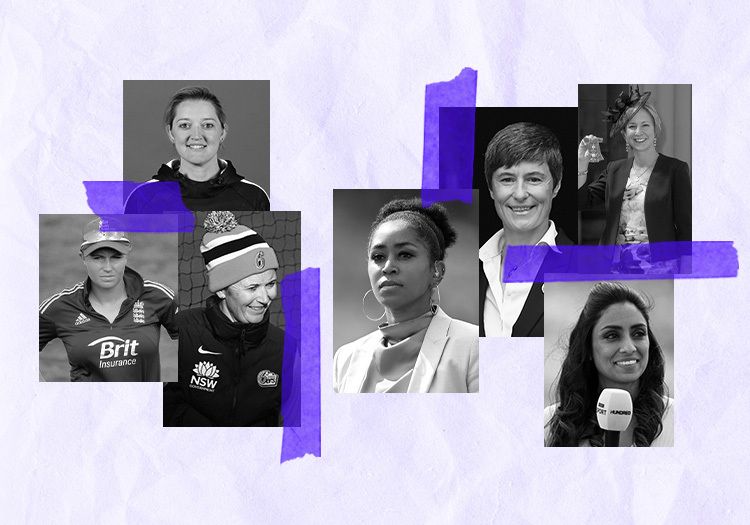NICK FRIEND - SPECIAL REPORT: Spread across the cricketing landscape, members of the England Women teams through the 2000s are running the show; this part of a wide-ranging project centres on Sarah Taylor, whose keeping transcended the women's game

Sarah Taylor is insistent: she never once considered a career outside of cricket, even when locked in an era of amateurism where the closest she might come to a salary was through lottery funding. It was all she'd known and all she could see herself doing.
Eventually, an admission: when she was 17, she enjoyed web design. "But I was so busy with cricket that I lost interest with it."
The early discovery of her talent meant she never went to university, which in turn meant she never stopped to think about the future, even though she'd always assumed that Loughborough was where she'd end up, since that's where you went to play women's cricket for England. She was a kid, and then she was a fully-fledged international, with no in-between.
So, there is an argument to be made that in 2006, the year of her international debut across all three formats, she became England's first female professional cricketer, eight years before there was such a thing: no side-hustle, no degree to fall back on, no get-out clause. Just cricket.
Indeed, there were only a few years between finding out that England had a women's team and being a central cog in it. "I just wanted to see how far it would go. I wanted to do it for a living." Living at home meant no outgoings, which gave way to delusional impressions of her wealth. She laughs: "I thought I had a lot of money, but I obviously didn't. At that point, I never thought it would be my career. I was just having fun, meeting people and playing a game that I enjoyed."
To reach that juncture, she had come through Brighton College, where Connor was her coach – an institution as close to a feeder product as existed in women's cricket for a long time, following in the footsteps of Clare Connor, Holly Colvin and Laura Marsh – and had played club cricket for Brighton and Hove, where much of the England squad was stationed as well. So, she knew early what her competition looked like and what it would take to make it.

The moment that sent Taylor viral: she pre-empted Jodie Fields' reverse-sweep and took it in her right hand (Charlie Crowhurst/Getty Images)
But Taylor's real benchmark was Sussex's academy, where she was part of the same intake as Will Beer, Tom Smith and Ben Brown, all three of whom have enjoyed long county careers. A teenage girl was the outlier in every which way, but she thrived because she had to. "I grew up really quickly," she recalls, "because I was training with guys who were very good cricketers. If you combine all of that, it made it really comfortable to then try the England environment."
No doubt, though, that was a strange existence: Brown, Smith and Beer followed the natural trajectory through the ranks and into professional contracts. All three are into their thirties now and, as much as stability doesn't exist in the ruggedness of elite sport, have enjoyed as much job security as it's likely to afford. Taylor, meanwhile, was in the academy – as was Colvin – but effectively playing for lottery funding: there were no contracts in the women's game; there was nothing tangible to aim for other than improving on her own excellence. So, that's what she did.
"I was just really enjoying the challenge of it all," she says. "You almost had to prove yourself every day because you were a girl. It wasn't about proving them wrong – because they never ever doubted me. But it was in the back of your mind."
Gradually, particularly through working with Michael Bates, Taylor's wicketkeeping started to transcend women's cricket. She had gone from making her England debut as a batter to being a frequent source of viral content: she might still be the most famous female cricketer in the country.
In 2013, that notoriety manifested itself as a rumour that Taylor was in the running to keep wicket for Sussex men's second team. In reality, that was little more than paper-talk. In her own summary: "It was massive, but it was nothing." A comment from an interview was taken out of its theoretical context, with Matt Prior on England duty and Brown injured. "I was asked: 'If I was available, would I do the club a favour? And yes, absolutely. That's my club. They grabbed that headline and went with it.
"It was massively blown out of proportion. I was never asked to actually play. It was a last resort and I accepted that. But absolutely I'd have given it a go."

Sarah Taylor might still be the most famous women's cricketer in England (Mike Hewitt/Getty Images)
So, a myth debunked, though Taylor was the first woman to play in Australia's first grade competition. Fast-forward a decade, and she isn't playing anymore. At 33, that still feels like a crying shame.
No one ever doubted her, and Adam Gilchrist christened her as the world's best wicketkeeper, regardless of gender. But the reality – a story well told by now because of her own openness – is that Taylor doubted herself, struggling quietly with the veneration that came her way, until it all came flooding out in an interview with the BBC.
She hadn't planned back then to be the mental health advocate that she has become – when Taylor last spoke to The Cricketer, it was to launch a mental wellbeing hub through Sussex – but she is more than happy to play her part now. She is a sounding board for other players going through similar things – "if you have a squad of 15 to 20, I swear there will be two, three or four who are going through something of the heaviness that I was going through, and then there are others who just need a handling of things every now and then," she says – and her main focus these days as a coach means that pastoral care is part of the job.
Looking back to that interview in 2016, Taylor's motivation was no more elaborate than simply to clear up the reasons for her taking a break from cricket, sick of seeing rumours suggesting that she was "taking a stance" on Edwards' sacking as England captain a month earlier.
Seven years on, Taylor exists as one of several English cricketers who, by lending their voice to the mental health cause, have made the game a safer space.
"I am really proud of myself," she says, speaking now from a place of happiness, where she has learnt to manage those struggles. "I was getting a lot of messages: Charlotte had left, then I left. Everyone was accusing me, but it had nothing to do with that. That's why I really did that interview.
"From that, the response showed me that there were so many other people feeling the same way and in the same boat. My life was out there. You could read about it, you could watch it. Why did I have to be ashamed about it anymore? That's what I was going through, that's what I am still dealing with."

Sarah Taylor returned briefly to top-level cricket in 2021 for The Hundred (Stu Forster/Getty Images)
Being the world's most talked-about female cricketer of the time was the last thing she needed. Gilchrist's adulation, the non-stop praise, the viral videos, the reaction to her catch off Jodie Fields' reverse sweep: she wishes, with hindsight, that she'd sat back and appreciated it all.
"I almost pushed myself away from things when I should have just enjoyed them. I wanted people to stop talking about me because I didn't want the attention.
"The more successful I got personally, the more I wanted to hide. The higher profile that we had – we were on TV more – meant we were up for more criticism. How some of the girls handled it, I was just amazed. It was what we were fighting for.
"For me, that was the upsetting thing: we were fighting for full-time contracts and more exposure, but my brain decided to walk the other way unfortunately."
If Taylor was 23 again, a decade younger, and in the dressing room of Jon Lewis' England, things would be different, she reckons. But perhaps – for the sport to understand how to deal better with that predicament – it needed examples like hers.
"I don't think we were really that aware of how to deal with things," she says, thinking back to the culture of the time.
"You'd find yourself scrolling through Twitter and you could have a million nice comments, but you'd remember the one terrible comment. I didn't deal with that. Any kind of criticism, I was looking out for it because that's probably what I felt. I needed that confirmation.
"From what I hear, the girls are really looked after now. I'm really happy that it's gone that way because there are some incredibly talented players in that squad and some youngsters. If they can learn to deal with that, then all the better."
Over six sections - available via the links below (and all free to read on March 8, International Women's Day) - this project tells the story of how these women graduated from their careers as international cricketers to become industry leaders following their retirements.